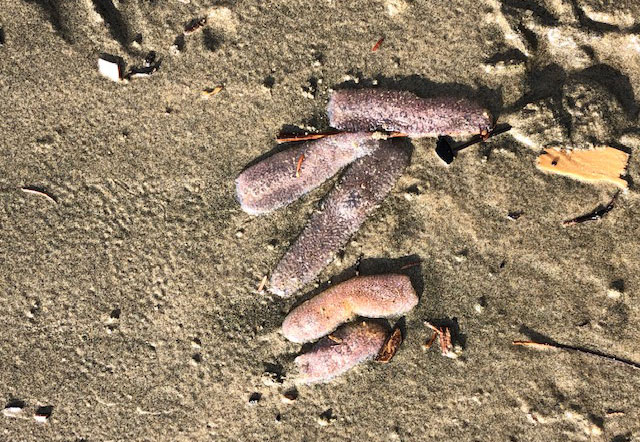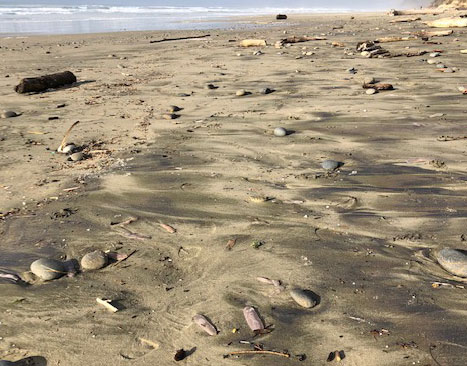Wacky, Tubular Pyrosomes Found Again on Oregon Coast: Will This Bring More?
Published 02/03/22 at 5:50 PM PST
By Oregon Coast Beach Connection staff

Includes exclusive listings; some specials in winter
In Cannon Beach:
Includes rentals not listed anywhere else
In Manzanita, Wheeler, Rockaway Beach:
Some specials for winter
In Pacific City, Oceanside:
Some specials for winter
In Lincoln City:
Some specials for winter
In Depoe Bay, Gleneden Beach:
Some specials for winter
In Newport:
Look for some specials
In Waldport
Some specials for winter
In Yachats, Florence
Some specials for winter
Southern Oregon Coast Hotels / Lodgings
Reedsport to Brookings, places to stay; winter deals
(Florence, Oregon) – An old pal of sorts is back on the Oregon coast. That familiar, tubular shape of the pyrosome has returned – at least for a little bit – and in some places there are great numbers of them. (Photo above courtesy Seaside Aquarium from back in 2017)
In Seaside, Seaside Aquarium found one. However, down in Florence, from quite a ways south of town all the way up to Muriel Ponsler Memorial Wayside, there are sometimes hundreds of them, depending on the beach. Reports came in from the Siltcoos River near Dunes City on the southern Oregon coast, as well as Heceta Beach below the Heceta Head Lighthouse, and Hobbit Beach, among others.
Oregon Coast Beach Connection readers are also noting farther south around Coos Bay and Port Orford in sizable amounts.
Pyrosomes are somewhat gelatinous in feel but they're not related to the jellyfish at all – they're more closely related to the salp. These rather strikingly oddball creatures made quite a sudden splash on the Oregon coast back in 2016 and 2017, showing up in enormous numbers on and off before trailing off in 2018. Biologists were puzzled by this at the time, because such a flood of them had not occurred before, at least on record.
Then, the big numbers simply stopped, with the occasional rare sighting since. Now, they appear to have showed up again in larger-than-normal numbers, although the reports seem confined to south central coast.
Mary Nulty, a volunteer and historian with the Heceta Head Lighthouse, checked out a few beaches over the weekend. At Heceta Beach, there were about 100 lying around. At Washburne, Nulty said something like 1,000 were seen on that wide area, and quite a few at the Siltcoos River.

Photo courtesy Mary Nulty - pyrosomes this weekend near Florence
“They were all in the high tide line mixed in with small debris and lots of small bits of plastic,” Nulty said.
Just about all the finds noted, including those by other Florence residents on social media, were flattened and not round and whole, as is often seen. They were also sometimes their usual purple and sometimes brown or pink, a sign that they've been around a bit and are decomposing.
Does it mean there's going to be more runs of them up and down the coastline? That's hard to predict.

Photo courtesy Mary Nulty
Whatever will happen, part of the reason for so many is warmer-than-usual waters off the Oregon coast, another point of climate change that is worrying experts. The other main reason for seeing them is just west winds or recent storms.
These creatures are remarkably odd – more so than the average person will know by looking at it. Each rounded individual is actually a colony of smaller creatures about one centimeter long. They are all connected by tissue and in turn form this colony that looks like a plastic tube.
They're technically a tunicate, something related to a salp, according to Tiffany Boothe of Seaside Aquarium. And there's more special surprises.
“This colony of animals is comprised of thousands of individual zooids and moves through the water column by the means of cilia,” she said. “They filter plankton out of the water for food and are known for bight displays of bioluminescence. In fact, their scientific name is derived from the Greek words pyro meaning 'fire' and soma meaning 'body.' “
However, you won't see them glow at night on the beach: they'll only do that when they're still alive and in the water.
Oregon Coast Hotels for this event - South Coast Hotels - Where to eat - Maps - Virtual Tours
Cannon Beach Lodging
Nehalem Bay Lodgings
Manzanita Hotels, Lodging
Three Capes Lodging
Pacific City Hotels, Lodging
Lincoln City Lodging
Depoe Bay Lodging
Newport Lodging
Waldport Lodging
Yachats Lodging
Oregon Coast Vacation Rentals
Oregon Coast Lodging Specials


Photos courtesy Mary Nulty
More About Oregon Coast hotels, lodging.....
More About Oregon Coast Restaurants, Dining.....
LATEST Related Oregon Coast Articles
A new roadway arose with more sunken asphalt. Traffic
Waves 17 to 26 Ft Along Oregon Coast: Surf Advisories, Sneaker Waves
A good show from Washington southward but some deadly possibilities. Weather
Two Videos Show Different Angles on Near-Deadly Oregon Coast Wave
The incident from 2021 just surfaced, showing a wave knocking people around Cape Kiwanda. Weather. Safety
Oregon Coast Town Looks at Possibility of Life Out There with Yachats Event
Jan 11 at the Yachats Commons examines the moon Europa. Yachats events
Oregon Coast and Washington Coast Beach Safety - the Complete Guide, Alerts, ...
Advice and guidelines for Washington and Oregon: what to look out for
Comet 31/Atlas Caught By Portland, Oregon Man On Its Way Out
Snapped by a Portlander as it zips out of the solar system. Astronomy, sciences
Newport Police Investigate Two Stabbings and a Shooting Near Oregon Coast's H...
A man was shot as he was allegedly stabbing his second victim
Flood Advisories, Warnings, Watches All Over Washington / Oregon Coast
Advisories, watches and warnings in various areas except the central Oregon coast. Weather, traffic
Back to Oregon Coast
Contact Advertise on BeachConnection.net
All Content, unless otherwise attributed, copyright BeachConnection.net Unauthorized use or publication is not permitted



















































